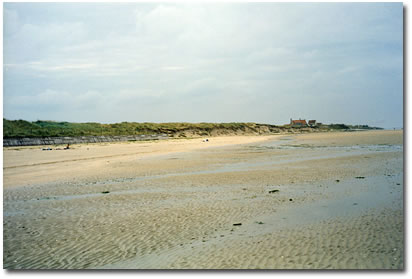|
|
|
|
|
|
 |
 |
|
|
| 9th
Infantry Division — World
War II — Normandy, France |
|
|
|
 |
 |
 |
 |
 |
 |
 |
|
Utah
Beach, Normandy, France
|
Following
rest and training in merry old England,
the 9th Infantry Division arrived
in Southampton and Weymouth by rail
and motor on D-Day, June 6, 1944,
for disembarkation.
The "Octofoil" began the
journey across the English Channel
to the Normandy beach dubbed Utah
on June 7, 1944 — D-Day-plus-one.
According to Joseph B. Mittelman's
Eight Stars to Victory: A History
of the Veteran Ninth U.S. Infantry
Division, 47 Liberty ships, eight
LSTs (Landing Ship Tank) and 12 LCTs
(Landing Craft Tank) were en-route
to support troops who had pushed inland
in Normandy on D-Day.
"It was June 10, 1944 —
D-Day-plus-four. To the front was
Utah Beach; down the shore to the
left stretched Omaha,
where so many gallant men of the 1st
and 29th infantry divisions had paid
the supreme price for freedom. Beyond
Omaha
Beach were the British and Canadians
— driving on the German strongpoint
of Caen," Mittelman wrote in
Eight Stars to Victory.
"As the heavily-laden transports,
LCTs and LSTs made their way through
the danger zone, the approaching beach
grew larger in size. Ships were everywhere,
vessels of all types. Some had foundered,
some were anchored and still others
had become victims of enemy action.
Omaha had most of the half-afloat,
half-sunken boats; Utah was better
organized.
"The 4th Infantry Division had
landed on D-Day and pushed rapidly
inland to join forces with the 82nd
Airborne Division. Paratroopers of
the 82nd had dropped from the skies
during the first hours of the 6th,
and with their fellow jumpers of the
101st Airborne — fighting to
the south — had gone astride
the river areas and opened routes
of advance. Remains of gliders were
everywhere . . . as well as bodies
of those who had resisted their landings.
"Up and down the VII Corps beach
were the men of the 1st Engineer Special
Brigade — they were the invasion's
room clerks and work horses, who welcomed
new tenants onto the soil of France
and evacuated the dead and wounded.
Confusion was present, but seemed
less on land than it did in the seaborne
ferrying of men and material, weapons
and vehicles. Many landing craft had
become dried out (beached to permit
unloading) and the once-light sand
had taken on a dirty appearance."
[ story
continued . . . ]
[ Back
to Photographs • Next
Photograph ]
|
 |
 |
 |
|
|
 |
|
 |
|
|
|
|
|
|
|
|
|
 |
 |
|
